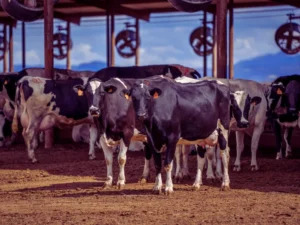Leveraging LF RFID Technology for Livestock Feeding Behavior Monitoring: Advancing Health Insights
Summary
Agricultural engineers from the U.S. Department of Agriculture (USDA) have developed a low-frequency (LF) RFID-based system to track livestock feeding behaviors. This system, tested at the Roman L. Hruska U.S. Meat Animal Research Center (USMARC), captures the unique RFID tag IDs of cattle and pigs when they approach feed bunks or troughs. The system monitors feeding patterns without disrupting natural behaviors. The collected data offers valuable insights into livestock health, environmental impacts, and early illness detection. Currently, the system is undergoing further evaluation for commercial use.
Introduction to LF RFID-Based Feeding Behavior Monitoring
Challenges in Traditional Livestock Monitoring
Monitoring livestock health in large-scale operations has been time-consuming and prone to error. Early detection of illnesses is crucial for animal welfare and farm profitability, but standard methods often miss subtle signs. This challenge has led to the development of advanced technologies like LF RFID to improve precision in tracking individual animal behaviors and health.
Implementing LF RFID Technology for Feeding Behavior
The USDA’s innovative LF RFID system tracks feeding behaviors without altering the animals’ routines. With LF RFID ear tags, the system monitors how long animals feed, where they prefer to eat, and how often they eat. These patterns can provide early warnings of illness or stress, allowing farmers to intervene promptly.
System Design and Operation
Cattle Feeding Monitoring System
The system was initially designed to monitor cattle in 16 feedlot pens, each containing eight cattle. Two Texas Instruments Series 2000 LF RFID readers connected to 96 antennas were placed at the feed bunks. Each cow had an Allflex half-duplex 134.2 kHz RFID ear tag, which worked within a 30-inch range. The system recorded data every 30 seconds, linking it to each animal’s ID for analysis.
Custom software running on Microsoft Windows collected and processed the data, allowing real-time diagnostics to ensure proper antenna functioning. By scanning regularly, the system provides comprehensive insights into the herd’s health and feeding behaviors over time.
Adapting the System for Swine
The LF RFID system was adapted for use in a swine facility, where each pen housed 40 pigs. Each feeding station had a five-hole feeder equipped with an RFID antenna. Pigs, tagged with custom LF RFID tags, had their feeding behavior monitored every 20 seconds. The system tracked individual feeding patterns, providing valuable insights into each pig’s health and growth rate.
Video validation confirmed the accuracy of the RFID data, highlighting trends like male pigs eating more frequently than females and faster-growing pigs spending more time at the trough.

Behavioral Insights and Health Monitoring
Early Detection of Illness Through Feeding Behavior
One of the most valuable aspects of the LF RFID system is its ability to detect early signs of illness. During a disease outbreak, researchers observed that sick animals significantly reduced their feeding time, which served as an early indicator of illness before other symptoms appeared. This data allows farmers to isolate and treat affected animals sooner, reducing the spread of disease and improving herd health.
Growth and Environmental Impact on Feeding
The system also revealed key trends related to growth and environmental conditions. For example, pigs increased their feeding time as they matured from two to three-and-a-half months. The data also showed that male pigs spent more time eating than females and faster-growing animals fed more frequently. This information can help optimize feeding strategies and improve productivity.
Frequently Asked Questions
- How does LF RFID technology help monitor livestock feeding behavior?
The system uses LF RFID ear tags that record the animal’s feeding times and patterns. As animals approach the feed bunk or trough, their RFID tag is read, and the data is transmitted to a central system for analysis.
- What advantages does LF RFID offer over traditional monitoring methods?
LF RFID allows for real-time, non-intrusive monitoring of feeding behavior, providing precise data on each animal without disturbing their natural routines. This technology can detect early signs of illness or stress more effectively than visual inspections alone.
- Can this system be used in commercial livestock operations?
While the system is currently in the research phase, it shows promise for commercial application. Further validation and refinement are needed, but it has the potential to improve health monitoring and management in commercial livestock facilities.
- How is the system adapted for use with different animals, such as cattle and pigs?
The system has been successfully adapted for both cattle and swine by modifying the RFID tag placement and feeder design. The system collects and analyzes feeding behavior data specific to the animal type in each case.
- What insights can farmers gain from this system?
Farmers can track individual feeding behaviors, detect early signs of illness, and optimize feeding strategies based on growth patterns and environmental conditions. This data allows for more targeted interventions and improved herd management.
Comparison of LF RFID vs. Traditional Livestock Monitoring Methods
| Monitoring Method | Data Collection Frequency | Accuracy | Impact on Animal Behavior | Health Monitoring |
| LF RFID Monitoring | Every 30 seconds | High (Real-time, individual) | Non-intrusive | Early detection of illness |
| Manual Observation | Periodic | Moderate | Can miss subtle signs | Delayed detection |
| Video Monitoring | Continuous | High (Requires manual review) | Non-intrusive | Time-consuming analysis |
| Automated Feed Intake Systems | Continuous | Moderate | May alter feeding behavior | Moderate, slower intervention |
This table highlights the key differences between LF RFID technology and other monitoring methods, emphasizing the advantages of real-time, non-intrusive data collection for health monitoring and early disease detection in livestock.
The LF RFID system offers a promising new approach for tracking livestock feeding behaviors, providing valuable insights into animal health and environmental conditions while paving the way for more precise livestock management in the future.
